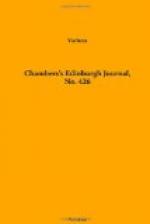THINGS TALKED OF IN LONDON.
February 1852.
Professor Faraday’s lecture, with which, according to use and custom, the Friday evening course at the Royal Institution was opened, has been the most noteworthy topic of scientific gossip since my last. The subject, ‘Lines of Magnetic Force,’ is one not easily popularised, otherwise, I should like to give you an abstract of it. One requires to know so much beforehand, to comprehend the value and significance of such a lecture. The learned professor’s experiments, by which he demonstrated his reasonings were, however, eminently interesting to the crowded auditory who had the good-fortune to listen to him. He promises to give us, before the close of the season, another, wherein he will make use of that telescope of the mind—speculation, and tell us much of what his ever-widening researches have led him to conclude concerning magnetism; a science on which he believes we are shortly to get large ‘increments of knowledge.’ Mr Wheatstone, too, having produced a paper resuming his stereoscopic investigations, had the honour of reading it before the Royal Society as their Bakerian Lecture, as I prognosticated a month or two since. Of course in this practical age the inquiry is put—Of what use is the stereoscope or pseudoscope? With respect to the former, it is said that artists will find it very serviceable in copying statuary groups; and a suggestion has already been made, to adapt it to the purposes of microscopic observation, as the objects examined will be seen much more accurately under the extraordinary relief produced by the stereoscope, than by the ordinary method. And it may interest astronomers to know, that Mr Wheatstone believes it possible, by means of the same instrument, to perfect our knowledge of the moon’s surface and structure. For instance: he proposes to take a photographic image of the moon, at one of the periods of her libration, and a second one about fifteen months afterwards, at the next libration, which, as you know, would be in the opposite direction to the first. The two images being then viewed in a stereoscope, would appear as a solid sphere, in which condition we should doubtless get such an acquaintance with the surface of our satellite as can be obtained by no other means. The reason for taking the images with so long an interval between is, that although each one represents the same object,




